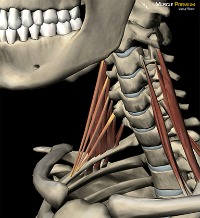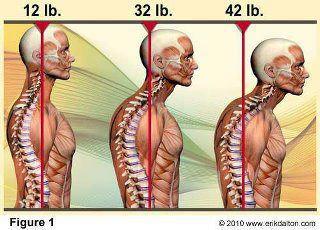The Scalenes
What Are The Scalenes?

The neck is supported on the sides by a group of muscles called the scalenes. These muscles help your head and neck tilt to the side, toward the side-front, side-middle, or side-back. They also assist your head in turning to the right or left.
They will also play a role if your head is more forward of your torso, or what is known as "forward head" where the chin juts out to the front. In this case, the scalenes shorten in concert with the sterno-cleido-mastoid muscle (the large muscle on either side of your adam's apple), pulling the head forward.
The Scalenes, The First Rib And Gravity

The scalenes originate at the base of the skull, just behind the ear. The other end of each of the scalenes attaches to the first rib which is located just behind and below the collarbone. When the scalenes are tight, they can pull the first rib upward. This is what happens when you hold a phone between your ear and your shoulder. As a result of all this tension, the fascia associated with the scalenes and all the structures nearby begins to thicken, dry out and become sticky. Over time, these muscles become glued in this position, leading to chronic neck pain. Here's why.
Your head weighs about 12 pounds. When it is not in its proper place, sitting directly on top of your shoulders, your muscles have to hold on to keep the 12-pound ball that is your head from falling over. This means that there is constant stress on the muscles in the neck. If your head is tilted to the side, it is the scalenes that are doing the job of supporting your 12-pound head. While the scalenes on one side of your head are shortened in contraction and pulling your head to that side, the same muscles on the other side of your neck are also contracted, holding onto your head so it doesn't roll off your shoulders. A tremendous amount of constant tension and compression is created.

In the illustration above, notice how the scalenes which span the distance between the back of the ear and the collarbone shorten as the head moves forward. Once this kind of structural stress becomes chronic, the fascia in the area will glue the scalenes in place, possibly impinging the brachial plexus, leading to the symptoms of TOS.
The Scalenes And The Brachial Plexus
The bottom attachment point for the scalenes is along the first rib. If they are chronically contracted, the first rib can get pulled upward, compressing the space between the first rib and the collarbone. Because the brachial plexus (the nerve bundle that feeds the arm) passes through this area, this can lead to the devastating symptom of numbness in the whole arm. In its worst form, this condition is known as Thoracic Outlet Syndrome, but you can experience varying degrees of involvement that can be very confusing and hard to diagnose.
Restoring the scalenes to their normal length and proper function involves releasing the adhesions that are bonding the scalenes to neighboring structures and locking them in their shortened state. Fortunately, this is not hard to do once you learn the correct techniques that can help avoid further injury.
You can learn more by visiting the following links:
Click the block below that most closely matches your injury for more information and to find the Toolkit we offer to help you in your recovery.







